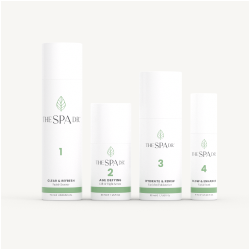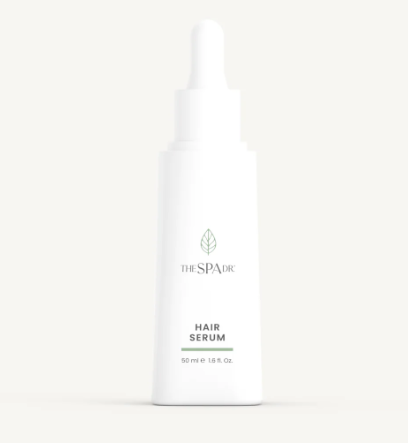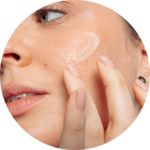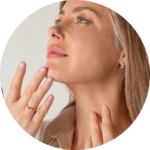If you have oily skin, you know how challenging and frustrating it can be to deal with. You may feel embarrassed, especially with acne breakouts, blackheads, whiteheads, and enlarged pores. If you have oily skin, you may also have sebaceous hyperplasia (yellowish, soft, small papules on the face, usually on the nose, cheeks, and forehead). You may find yourself wondering if your oily skin will ever go away or improve. And if you do, you’re going to love these myth busters.
Because many people attempt to control oily skin with actions that actually damage skin, solving the problem of oily skin requires busting the myths and figuring out how to truly address it. Let’s bust them so you can get your most radiant skin yet, and properly care for naturally oily skin. After all, in a balanced state, oily skin has benefits too!
Myth #1: Oily skin needs foamy and super thorough cleansing
When you look in the mirror and your face is shinier than you prefer, it is tempting to wash it until it’s squeaky clean. But this actually leads to overwashing and stripping your skin, which can do more harm than good. One of your skin’s major functions is to provide a barrier to the outside world. The skin’s secretion of natural oils (sebum) helps keep it hydrated and healthy. And, it helps create an environment where beneficial microorganisms can grow.
The collection of bacteria, viruses, fungi, and other microbes is called the skin microbiome, and when it’s out of balance, your skin is more likely to break out in acne.
When you overwash your skin, it can damage this natural protective barrier. Washing your skin twice daily with a gentle balancing cleanser is enough to properly cleanse your skin. If you are still concerned about oil throughout the day, use blotting papers to gently remove excess oil. But when you’re using the right cleanser, you’ll likely notice within 30 days that you no longer have that afternoon excess shine.
Myth #2: Alcohol-based toners are good for oily skin.
If you’ve tried just about everything to dry up oil, then you’ve definitely used alcohol-based toners and other topical treatments on your skin. Skin treatments, including alcohol-based products that are designed to dry up oily skin, disrupt your skin’s natural barrier function. While trying to treat oily skin, you could actually make it worse and disrupt your skin’s microbiome. Plus, if too much oil is stripped from your skin, it will react by overcompensating and producing even more oil. Instead of a toner, what you want after cleansing is a high-quality serum that restores the pH of your skin without stripping or disrupting it. Your skin needs a natural mild acidity to maintain a healthy skin microbiome that helps keep your skin blemish-free.
Myth #3: Oily skin doesn’t need moisturizing.
Many people with oily skin avoid using moisturizer because they think it leads to more oil production. Moisturizing the skin properly helps manage sebum production.
Even oily skin needs to be moisturized daily.
Moisturize both morning and night to hydrate and plump your skin, but be sure to use a moisturizer that has the proper pH to support healthy skin. Research shows that the pH of your skin care products should ideally be in the 4.5 to 5.0 range to support a healthy skin microbiome. To find out if your moisturizer and other skin care products are in the ideal pH, simply use a pH strip and test the pH. (Note: Products with only oils will not have a pH so those cannot be tested.)
Myth #4: You can’t use essential oils on oily skin.
This is one of the biggest skin care myths out there, but putting the right oils on your skin does not make it oilier. The key is the type of oil. Many plant-based oils actually have anti-microbial and anti-inflammatory properties. For example, argan oil is highly moisturizing and is restorative to the acid mantle, leaving behind luminous and soft skin. Because argan oil is a non-clogging, anti-inflammatory, and regenerative agent, it nourishes oily skin in a healthy way. Finding a plant-based oil blend can provide hydration without breakouts.
Myth #5: You need a skin care brush or heavy exfoliation to remove oil from oily skin.
Oh, heavens no! Stripping the skin of too much oil actually leads to the skin producing even more sebum. With an abundance of skin care tools on the market, it is tempting to use skin-brushing and other exfoliating facial tools to cut down on oil. The key here is finding the right balance. Gentle exfoliation used sparingly (once or twice a week), can cleanse skin without stripping it of oil or disturbing the microbiome.
Don’t let oily skin get you down. By learning more about how to properly care for oily skin, you can maintain it with the proper skin care routine that is tailored to your skin type. And by addressing the root causes of your oily skin, you can get on a better path to optimal health and vitality.
Olivia skin types usually have oily skin. Are you an Olivia skin type? Find out by taking the skin quiz.









Reader Interactions